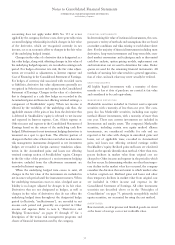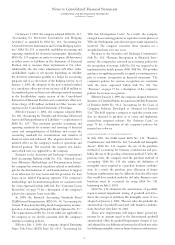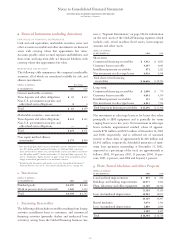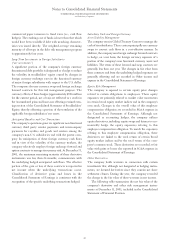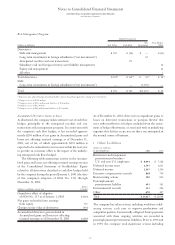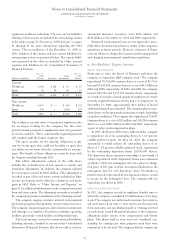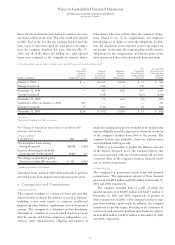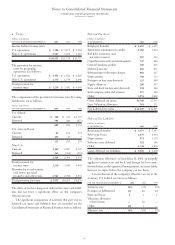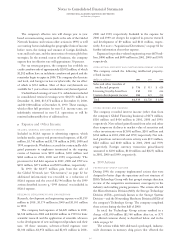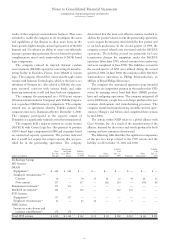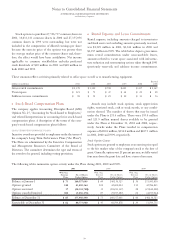IBM 2001 Annual Report Download - page 87
Download and view the complete annual report
Please find page 87 of the 2001 IBM annual report below. You can navigate through the pages in the report by either clicking on the pages listed below, or by using the keyword search tool below to find specific information within the annual report.
Notes to Consolidated Financial Statements
INTERNATIONAL BUSINESS MACHINES CORPORATION
and Subsidiary Companies
85
Annual maturities on long-term debt outstanding at
December 31, 2001, are as follows:
(dollars in millions)
2002««« $«5,186
2003 3,106
2004 1,501
2005 1,904
2006 2,261
2007 and beyond ««««6,471
INTEREST ON DEBT
(dollars in millions) 2001 2000*1999*
Cost of Global Financing $««««964 $«1,082 $«1,100
Interest expense 238 347 352
Interest capitalized 33 20 23
To tal interest paid
and accrued $«1,235 $«1,449 $«1,475
*Reclassified to conform with 2001 presentation.
Refer to the table and related discussion on page 104 in note
v, “Segment Information,” for the total interest expense of
the Global Financing segment. See note k, “Derivatives
and Hedging Transactions,” on pages 85 through 87 for a
discussion of the use of currency and interest rate swaps in
the company’s debt risk management program.
LINES OF CREDIT
Effective May 31, 2001, the company replaced its $10 billion
committed global credit facility, which was due to expire in
February 2002, with two global credit facilities totaling $12.0
billion in committed credit lines, including an $8.0 billion
five-year facility and a $4.0 billion 364-day facility. The com-
pany’s other lines of credit, most of which were uncommitted,
totaled $6,860 million and $7,646 million, respectively, at
December 31, 2001 and 2000. Interest rates and other terms
of borrowing under these lines of credit vary from country to
country, depending on local market conditions.
(dollars in millions)
AT DE CEMBER 31: 2001 2000
Unused lines
From the committed global
credit facility $«11,383 $«««9,103
From other committed
and uncommitted lines 4,738 5,111
To tal unused lines of credit $«16,121 $«14,214
kDerivatives and Hedging Transactions
DERIVATIVES AND HEDGING
The company operates in approximately 35 functional curren-
cies and is a significant lender and a borrower in the global
markets. In the normal course of business, the company is
exposed to the impact of interest rate changes and foreign
currency fluctuations. The company limits these risks by
following established risk management policies and procedures
including use of derivatives and, where cost-effective, financing
with debt in the currencies in which assets are denominated.
For interest rate exposures, derivatives are used to align rate
movements between the interest rates associated with the
company’s lease and other financial assets and the interest
rates associated with its financing debt. Derivatives are also
used to manage the related cost of debt. For currency expo-
sures, derivatives are used to limit the effects of foreign
exchange rate fluctuations on financial results.
The company does not use derivatives for trading or
speculative purposes, nor is it a party to leveraged deriva-
tives. Further, the company has a policy of only entering into
contracts with carefully selected major financial institutions
based upon their credit ratings and other factors and main-
tains strict dollar and term limits that correspond to the
institution’s credit rating. When viewed in conjunction with
the underlying and offsetting exposure that the derivatives
are designed to hedge, the company has not sustained a
material loss from these instruments.
In its hedging programs, the company employs the use of
forward contracts, interest rate and currency swaps, options,
caps, floors or a combination thereof depending upon the
underlying exposure.
A brief description of the major hedging programs follows:
Debt Risk Management
The company issues debt on the global capital markets,
principally to fund its financing lease and loan portfolio.
Access to cost-effective financing can result in interest rate
and/or currency mismatches with the underlying assets. To
manage these mismatches and to reduce overall interest cost,
the company primarily uses interest-rate and currency
instruments, principally swaps, to convert specific fixed-rate
debt issuances into variable-rate debt (i.e., fair value hedges)
and to convert specific variable-rate debt and anticipated





